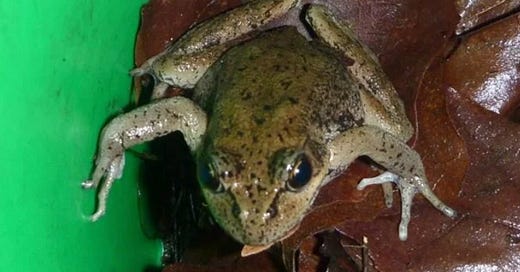In 2013 a resident of Northwest Portland was out for an evening stroll and encountered a parade of frogs.
A previously unknown population of red-legged frogs was trying to cross Harborton Road as part of a migration. Unfortunately, the frogs were being squished by traffic.
From that chance encounter was born a quirky frog taxi service that saves amphibian lives and captures so much of what I love about Oregon.
So this post isn’t about politics, or homelessness, or how to save lives through better women’s health programs. This is just a window into a nifty little program that brings good people together to save frogs — and a celebration of small solutions that solve problems around us.
The red-legged frogs in question live in Portland’s Forest Park, one of the largest urban forests in America, with 80 miles of trails. Forest Park gets grander fauna, even an occasional elk or bear, so the frogs don’t get much attention.
It turns out that the red-legged frogs must make an annual migration from Forest Park to wetlands that lie across two roads, two rail lines and a highway; later in the year, the frogs must make a return trip to Forest Park. Predictably, a considerable number of frogs end up as roadkill. So almost a decade ago, dozens of volunteers, working with biologists, started the Harborton Frog Shuttle, also known as the frog taxi.
The volunteers scoop up the frogs before the roads and then hand-deliver them to the wetlands, and later in the year they help them make the reverse trip. Think of it as Uber for amphibians — and every ride is five stars.
This frog shuttle has worked. It has sustained the frog populations, and it has probably sustained the human ones by giving us all something to coo about. And the humans are working on longer-term solutions, such as building ponds on the Forest Park side of the roads and highway, to avoid the need for frogs to migrate across traffic.
In the meantime, if you want to become a volunteer to assist the frogs, you can sign up here.
So, yes, I know there are bigger challenges in Oregon than frog traffic fatalities, but one of the things I’ve always admired about this state is its social capital, its innovation, its eagerness to do the right thing. We don’t always get it right — look at our homelessness problem — but even when we screw up, we often do so with good intentions.
I’d like to think that if volunteers can come together out of compassion for frogs, and work with scientists on evidence-based approaches to reduce amphibian mortality, we can surely also do better with evidence-based approaches to tackling homelessness, mental health, addiction, child care and more.
If we can come together to meet frog transportation needs, there’s hope that we may yet better address our human transportation concerns. If we can solve frog problems, we can surely do better at solving our own.





It's the little things that all add up. Thank you for sharing this. It brings tears of joy to my eyes.
In Germany I saw other ways of helping toads and frogs across. Both are starting with a 20 cm high netting next to the road (both sides) which prevents them getting across. Has to be the full length though! Then either a small tunnel is dug or a set of buckets dug in. The animals move alongside the netting until they either find a tunnel or drop in a bucket. The buckets are emptied on the other side of the road. Easier than one by one by individual persons.